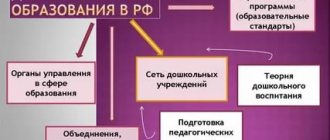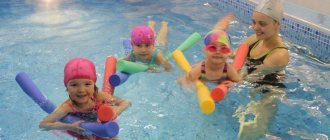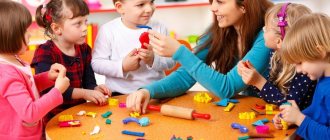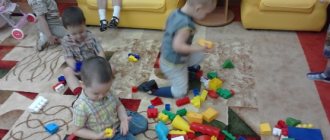Child development - tips on child development from Childdevelop
Pedagogical science does not define clear criteria for such a concept as the early development of children. The only stereotype fixed in the heads of parents is that a child should be able to read and know the basics of mathematical calculation by school. Information about child development is contradictory and varied. Let us only focus on the fact that in the period from 2 years to 6 years, a child learns about the world and receives information about its patterns and basic concepts. It is during this period that it is necessary to focus on the development of basic skills and abilities. The main thing here is to formulate the child’s concepts in coordinates - what is good and what is bad. Proponents of early development during this period of children’s lives suggest starting to study foreign languages and specializing the child in a certain direction - from music to higher mathematics.
What's negative about this? One. Do not deprive your child of a carefree and happy childhood. Give freedom of action and choice. Here are some basic child development tips from Childdevelop.
Publications by educators
How to obtain a Certificate of publication in the media for an educator, educator, teacher at MAAM. For evidence: register, publish material, draw up a document.
The best articles for the month in the library at MAAM: original works - winners of professional pedagogical competitions on topics of preschool and school education and development.
Total published: 711 000.
Materials found: 197 Shown: 1 - 10
Inclusive education. Pedagogical support for a child with visual impairment.
Pedagogical support for a child with visual impairment. A child with visual impairment needs increased attention from the teacher, competent construction of his educational route, construction of his trajectory...
The significance of Tuvan national games in correctional work with children with musculoskeletal disorders
Modern approaches to the organization of special education should be based on scientific concepts that make it possible to predict the results of pedagogical work. In this case, it is necessary to take into account not only global experience in the field...
Physical education and health work with children with mental retardation
With the arrival of a preschool institution, a child begins a new stage in his life. During the first time the child is in kindergarten, the behavioral reaction is complicated, sleep, nutrition, and communication are disrupted (the child does not do well...
Sensory development of young children based on the game “Frames and inserts by M. Montessori”
I work with young children. The kids who come to our group practically cannot speak. Based on this, the main tasks that we face are the development of children’s speech. It has long been known that children’s speech directly...
Choreography as a means of comprehensive development of a preschooler
Choreography as a means of comprehensive development of a preschooler Huge opportunities lie in the synthesis of music and plastic arts, the integration of various types of artistic activities. This was known back in the days of ancient Greece, where...
The use of the technological technique “Testing” in the life activities of preschool children
In connection with the new requirements of the State Educational Standards for the organization of the pedagogical process in senior preschool age, it is necessary to provide an intellectual background based on cognitive and research activities, to contribute to the expansion...
Integration of genres of Russian folklore and folklore of the peoples of the North as a condition for the formation of a careful attitude towards nature in children
The article is devoted to the use of methods for integrating different genres of Russian folklore and the folklore of the peoples of the North, in the formation of a careful attitude towards nature in children of middle preschool age and the conditions for their use. Security…
Cooperation between children and adults in the process of identifying, supporting and developing children's giftedness
Children's giftedness Methodist of the Ulybka State Communal Enterprise E.V. Britvina The future is much closer to us, it is very close: it cries, laughs, poses questions, makes us suffer, rejoice, look for answers. This future is children. Live…
Scientific and methodological support for the process of experimental and innovative development in preschool organizations
Methodist of the State Municipal Communal Enterprise “Smile” in Lisakovsk: Britvina E.V. A distinctive feature of modern education is dynamism. Innovative activities of preschool institutions, intensifying in the context of modernization of education, require...
Article for the magazine “Preschool Project Siberia”. Let's learn to live together.
Lately, discussions have often arisen about a tolerant world, a world without violence and cruelty, in which the main value is the unique, inviolable human personality.
But so far the theoretical mood is not... Pages: ...
All sections
Article on the topic: “The main problems of preschool education and ways to solve them” article
Article on the topic:
“The main problems of preschool education and ways to solve them”
Prepared by music director
In preschool educational institution No. 11 “Cherry”
Volsk city, Saratov region
Minnikova Irina Nikolaevna
2021
Introduction
Preschool education is an important component of the country’s social life. A lot depends on the quality of education in preschool educational institutions, so preschool education is now considered as the most important socio-forming factor.
To ensure favorable living conditions and upbringing of a child, the formation of the foundations of a full-fledged, harmonious personality, it is necessary to strengthen and develop close connections and interaction between the kindergarten and the family. Amendments were made to the Law “On Education in the Russian Federation”, which came into force on April 5, 2021.[1] One of the areas is educational activities, which are carried out outside the framework of educational programs. It includes not only the dissemination of knowledge, experience, the formation of skills, abilities, physical development, but also the instillation of values and spiritual and moral education.
The relevance of this topic is determined by the fact that it is in preschool age that all the basic personality traits are formed in a child and the quality of his further physical and mental development is determined. If you ignore the peculiarities of a child’s development at this age, this may adversely affect his future life. Each preschool educational institution not only educates the child, but also advises parents on issues of raising children. A preschool teacher is not only a teacher of children, but also a partner of parents in their upbringing. Raising and raising a child correctly in these rapidly changing times is not an easy and very labor-intensive process. A modern teacher, in his direct work with children in preschool settings, is faced with new problems in teaching and raising preschool children, which practically did not exist a decade ago.
- The main problems of modern preschool education. Person-centered approach.
At the present stage, one big problem can be identified - the problem of social and moral education, which is associated with the fact that in the modern world a person lives and develops, surrounded by many different sources of strong influence on him, both positive and negative, which befall him every day. fragile intellect and feelings of the child. As you know, it is impossible to live in society and be free from society. No matter what high demands are placed on a preschool institution, the problems of social and moral education cannot be solved only within the framework of preschool education.
Currently, the family in Russia is experiencing a severe crisis: the number of intra-family conflicts, divorces is growing, the number of families at social risk, single mothers and unemployed women has increased. Many parents do not have such a concept as “responsibility” for raising their child. This situation undoubtedly affects the education of the future generation.
The need to develop a child’s communication skills is an important job for teachers and parents. Communication includes the ability to hear and listen, the ability to make contact with peers and adults, the ability to express one’s thoughts, and understand speech.
Today there are a large number of single-parent families in which children are raised. There are some problems with this. Often in such cases, the child is left to his own devices, because the parent has no time to take care of his child. Unfortunately, most modern parents who have similar problems do not want to cooperate with preschool educational organizations, citing employment reasons.
The introduction of nanotechnology into life and general use has begun to play a major role in the development of a child in modern society. The Internet is now simply necessary; aspects of human life are connected with it. On the one hand, this is a positive phenomenon. It becomes possible for parents to develop their child in different areas. On the other hand, the Internet negatively affects the development of a child if parents, replacing communication, resort to the Internet, where there is a wide variety of cartoons, games, and various resources that captivate children into the virtual world. In addition, the basic knowledge system has ceased to play its former role today. For a person of the twenty-first century, what is much more important is not the amount of basic knowledge acquired in the family or school, but what he hears on the radio, sees on TV, reads in the newspaper, learns from the conversations of people around him. Thus, there are problems in modern education. Without communication, it is impossible to develop the communicative side of a child’s personality. Without the cooperation of parents and kindergarten, the full development of the child is impossible.
Academician D.I. Feldshtein summarized fundamental academic research in recent years and outlined a range of 16 significant changes in modern children and adolescents.[2] Of these, some related to preschool children can be identified:
- A sharp decline in the cognitive development of preschool children.
- Increased emotional discomfort and decreased desire for active action.
- The departure of role-playing games from a child’s life and, as a consequence, a decrease in voluntariness and motivational-need sphere.
- Decreased curiosity and imagination in preschoolers, underdevelopment of the internal plan of action.
- Insufficient development of fine motor skills and, consequently, graphic skills in preschool children indicates the underdevelopment of the corresponding brain structures, including those responsible for voluntariness.
- The rise of screen addiction.
- Asthenia of physique and decrease in muscle strength.
- Increasing number of children with disabilities.
2. Ways to solve problems of social education
The main element of any structure or system is people. Kindergartens should be staffed by those who really want and know how to work with children, who love and are ready to learn to communicate, who strive to constantly grow, master the best, new things and bring this to the kindergarten. In order to provide a kindergarten with such employees, they need to be paid a decent salary. This condition is a consequence of the fact that promising employees work full-time in the educational field. The development of children largely depends on the subject environment around them: toys, manuals, materials for drawing, modeling, design, books, musical instruments, physical education equipment, etc. Unfortunately, the state allocates little money and also poorly finances the purchase of didactic materials for teachers and methodological literature.
Teachers themselves organize their work with children, because it is in this age period that children absorb information like a “sponge.” The child is often active in learning new things and is interested in new things, which means that it is necessary to introduce modern technologies and methods into modern preschool education that meet the new times.
The existing problems of preschool education must be solved by carefully approaching each of them separately.
| Problem | Solutions |
| Try to devote more time to conversations, didactic and role-playing games with the establishment of social priorities, moral and family values. Include short-term and long-term projects in the educational process. |
|
|
| To accustom children to independent developmental activities, which include: creativity, drawing, physical activity, music. Instill a love of books (listen to fairy tales, short stories, stories.) Focus parents' attention on minimizing watching cartoons and playing games on various electronic media. We communicated more with the child, developing communication skills. |
| Use all components variably - help, protection, assistance, interact with each child in routine moments, on walks, in organizing meals, in play activities, ECD. |
| Using various forms of cooperation with parents
Such interaction will provide an opportunity to develop their interest in education issues, will arouse a desire to expand and deepen the knowledge that they use in raising a child, and will develop their creative abilities in activities aimed at the child. It is necessary to influence parents in such a way that they try to be with the child throughout preschool age and help him. |
Conclusion
Based on all of the above, we can say that the modern education system can be effective only if favorable social and pedagogical conditions are created. Social education of preschool children will be effective only with a personality-oriented approach.
The dialogue between the kindergarten and the family is built, as a rule, on the basis of the teacher’s demonstration of the child’s achievements, his positive qualities, abilities, etc. The teacher in such a positive role is accepted as an equal partner in education. In order for parents to become active assistants to teachers, it is necessary to involve them in the life of the kindergarten.
A child should leave kindergarten sociable, inquisitive and ready to perceive new information. Children must be taught to follow social norms. Without a doubt, preschool age is a unique period for personality development. Speaking about updating preschool education, I would like to emphasize that federal state educational standards will bring a lot of new things into the work of preschool institutions. The main criteria will be the socialization and individual development of the child, and not preparing him for school, as has been the case until now.
The training and educational activities of teachers undoubtedly require further study. Development of all kinds of teaching aids and tactics for the successful upbringing of children, and their implementation in the practice of preschool educational institutions.
Bibliography:
- Federal Law of April 5, 2022 No. 85-FZ “On Amendments to the Federal Law “On Education in the Russian Federation” - access mode: https://www.garant.ru/products/ipo/prime/doc/400442027/
- Feldshtein D.I. “Modern Childhood: problems and ways to solve them” - Bulletin of Practical Psychology of Education No. 2 (19) April-June 2009. – access mode: https://www.s-vfu.ru/universitet/nauka/
[1] Federal Law of April 5, 2022 No. 85-FZ “On Amendments to the Federal Law “On Education in the Russian Federation”
[2] Feldshtein D.I. “Modern Childhood: problems and ways to solve them”
Teaching principles are teaching methods, starting points that the teacher uses when selecting content, organizing and teaching methods. They reflect the internal natural aspects of the activities of the teacher and the child, determine the effectiveness of learning at various age stages with various forms of educational organization.
The principles of learning are not once and for all accepted categories. As psychological and pedagogical science develops, they are improved, acquiring a deeper justification (the principle of active learning, developmental learning, etc.)
At the same time, children develop a more loyal attitude to work, interest in the work activities of adults, and diligence. Teaching and upbringing are usually in one whole: by teaching, we educate, and by educating, we teach.
At the same time, training and education, as unique aspects of a single process, have their own composition, their own specific methods, their own material and psychological prerequisites. In the early stages of children's lives, education and upbringing appear in a closer unity, and it is difficult to differentiate them, but as the child grows up, upbringing and education become more clearly differentiated. But this does not mean at all that teaching loses its educational power, and education ceases to be educational. Education at all stages of a child’s development remains educational, and education remains educational.
The principle of science.
Its essence lies in the fact that real knowledge that correctly reflects reality should penetrate into the child’s consciousness. In the classroom, the teacher definitely forms in children specific ideas and knowledge about the world around them, which do not conflict with what the school will teach. A schoolchild’s initial scientific knowledge does not arise out of nowhere, but on the basis of real ideas acquired by children in kindergarten. Thus, a deeper scientific knowledge of reality arises on the basis of a less profound one. Undoubtedly, it is not easy to adhere to this principle when explaining the simplest things to preschoolers. Didactics is designed to prepare educational material in such a way that, on the one hand, it correctly reflects the surrounding reality, and on the other hand, it would be understandable and accessible to children.
The scientific principle ensures the formation in preschool children of elements of a dialectical-material understanding of the world around them.
Scientists have thought about this problem more than once. Where is the age limit, pointing to which we could say with confidence: this is the time when we need to begin forming the elements of a materialistic understanding of the reality surrounding the child. Many who understood the importance and relevance of this problem gave up in indecision when opponents cried out: is it possible to solve this problem regarding preschool age?
The principle of visibility.
The importance of this principle is determined by the specific thinking of a child in kindergarten. The principle of visibility is not new.
At the same time, it is possible that in the process of a child’s development, qualities are formed in him that are directly opposite to those that we would like to see.
The period of preschool childhood is a favorable time for the gradual formation in a child of the foundations of a scientific worldview, that the knowledge, experience of activity, attitude, behavior acquired at this age stage - all this, taken together, prepares in the child that qualitative leap that occurs in the process of forming a worldview on at a later age stage - schooling.
It is no coincidence that children strive to convey any story in figurative language, to imagine it in the form of some kind of visual picture or event. The most complex mental skills - reasoning, counting, proving, analyzing and comparing - come from initial external actions, from working with specific objects. To learn to count in your head, you need to work hard, counting real objects. Real objects and visual images contribute to the correct organization of children’s mental activity. The importance of visual learning is convincingly confirmed by studies that show that basic information is acquired by a person through visual and auditory perception. Visual information is perceived instantly. Auditory information enters our brain sequentially and takes much longer.
Implementing the principle of visibility in the pedagogical process of kindergarten means enriching and expanding the child’s direct sensory experience and clarifying his empirical knowledge.
In preschool institutions, the following types of visualization are used in the learning process: substantive and pictorial. Using object visualization, the teacher shows children natural objects of the outside world, three-dimensional images (stuffed birds, dummies of vegetables, fruits). When using visual aids, the teacher shows pictures, diagrams and other illustrative material.
In teaching children in the classroom, visualization is used primarily in connection with imparting new knowledge to children, as well as when consolidating it, when organizing children’s independent activities.
The following requirements are imposed on the visuals used in the classroom: they must fully reflect everything around them, correspond to the level of development of preschool children, be highly artistic in content and design,
The principle of accessibility.
What the child educator teaches must be understandable to him and also definitely correspond to the child’s development.
There is nothing that educators and psychologists argue about more these days than accessibility. What knowledge, at what age and under what conditions can be given to children? About 15 years ago, they still respected the traditional prohibition: you cannot start learning to read and write before the age of five. Today it is allowed to teach a child even earlier, as long as the rule is sacredly observed: to arouse interest, to encourage the child himself to expect the next “lesson.” If only there was no forced learning, teach with play, with passion.
To master literacy, a child must learn to distinguish the phonetic side of the text. In addition, children at this age are characterized by physiological tongue-tiedness (they do not know how to pronounce hissing, whistling sounds, etc.), which means that it is impossible to prepare them for direct learning to read and write.
An essential feature of the principle of accessibility is the connection of the acquired knowledge with that which has already been formed in the child’s mind. If such a connection cannot be established, then knowledge will be inaccessible to children.
However, what is accessible in teaching children cannot be used as an example of what is easy. Easy training does not cause any mental effort or tension in children, and therefore does not contribute to their development. Accessible learning always involves setting children such tasks, such tasks, the solution or implementation of which would be feasible for children and at the same time cause some strain on their mental powers.
The principle of activity and consciousness.
Experimental data show that if children do not show interest in learning, then the information coming from the teacher to the child is not perceived by them. Even with a child’s neutral mental state, information coming from outside is not perceived by the child’s brain.
The practice of kindergarten shows that many children are intellectually passive due to the fact that the teacher, when explaining educational material, does not provide in advance techniques that activate the child’s cognitive abilities, thinking and behavior, when he “chews” everything down to the smallest details himself, without relying on activity and independence of the child, who has no choice but to “swallow” the next dose of material.
The meaning of this principle lies in the fact that the more a child solves practical and cognitive problems on his own, the more effective his development is.
The most important indicator of the effectiveness of learning is the manifestation of cognitive activity and independence by children. The basis of this reaction is the indicative-exploratory reflex.
The development of the child’s cognitive abilities and creative powers depends on the teacher and the methods and techniques he uses.
Principles of systematicity, consistency and gradualism.
This means that the composition of the training and the specific tasks for its assimilation meet all didactic rules: to go in training from easy to more difficult, from what children already know to the new, unknown, from simple to complex, from close to distant.
Consistency involves studying educational material in such a way that the assimilation of new things is based on the children’s existing knowledge and prepares a further stage in children’s cognitive activity. Based on the program, the teacher determines and prepares the next “dose” of educational material for learning. Each such “dose”, part of the educational material, is presented in conjunction with the previous ones, in complication.
The principle of connection with life follows from the dialectical-materialist law of the unity of theory and practice. Of course, connection with life for young children is limited by their capabilities. Their life is play, work, activities. The acquired knowledge should be used in the specified activities.
The principle of developmental education.
This reveals the dialectical nature of the learning process. Amazing things happen to a child. Yesterday he still couldn’t do something, but today he learned. What seemed difficult yesterday has already been mastered and become simple today. Children gradually become aware of their own growth and become interested in learning. In order for learning to be an exciting, inspired work for children, it is necessary to awaken in children and constantly support the desire to learn, the desire to learn new things. It is this desire that is the emotional stimulus for the child’s independent and active thought. The secret of developing interest in educational activities lies in the child’s personal successes, in his feeling of growth in his capabilities, in mastering educational material. This means that the more success a child has in knowledge and learning, the higher and more stable his desire to acquire new knowledge.
The principle of taking into account age characteristics and an individual approach to children in education.
Children of preschool age differ from each other in everything, including speed of thinking, behavior, etc. Individual differences in children are explained by various natural characteristics, as well as different living and upbringing conditions.
The main way to study the characteristics of preschool children is systematic observation of the child; individual and group conversations; assessment of the results of their tasks, etc. The purpose of the study is to, based on the positive qualities of the individual, prevent and overcome existing shortcomings in the mental and moral development of the child.
The teacher must know what each child is capable of. Some of the 25-30 children quickly grasp the educational material, and some - slowly. You cannot demand the impossible from a preschooler. It is necessary to study the child’s personality, take a closer look at him, and identify his character.
An individual approach is used to create conditions for the comprehensive development of each child and prevent the influence of unpleasant circumstances on his development. Thus, during classes, children with impaired vision and hearing are seated closer to the teacher, closer to visual aids, so that they can better hear the explanation and clearly see the display of the sample and demonstration material.
The teacher restrains impulsive children with weak inhibitory reactions by developing their will. Some children, especially those who have just come to kindergarten, often have slow speech and an insufficient vocabulary. Such children should not be rushed when answering or telling stories. It is necessary to cultivate a favorable attitude towards them on the part of their comrades.
In kindergarten there are children who do not have the habit of mental work; they love to play, but are reluctant to do so. It is these children who need to be given the opportunity to experience the joy of success, which will increase their interest in the content of the lesson and in mental work.





